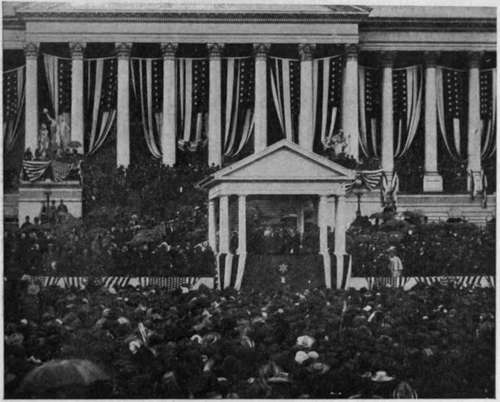Dewey At The Capitol
Description
This section is from the book "The National Capitol. Its Architecture Art And History", by George C. Hazelton, Jr. Also available from Amazon: The National Capitol Its Architecture Art and History.
Dewey At The Capitol
Perhaps no ceremony connected with the history of the Capitol has been more splendid than that in honor of Admiral George Dewey, October 3, 1899, when Congress honored the hero of -Manila with a sword, presented in the presence of official, military and civic Washington by President McKinley, upon a platform raised for the occasion on the east front of the building. It was a glorious day—all blue and gold. The Admiral had just returned to his native land, and his victories were deep in the hearts of the people. The President recognized that it was Dewey's day, and conceded the wild enthusiasm during the ride to the Capitol and the cheering of the populace gathered on the plaza to the great sea-captain. Upon their arrival, the President proceeded to the room in the Senate wing set apart for the Executive. The Admiral was received in the Vice-President's room. Thence, at the time appointed, the Commander-in-chief and the Admiral walked arm-in-arm to the east front, where their presence was greeted by a sea of faces and a deafening cheer from the multitude. The Admiral seemed reassured as his eye caught sight of his own " blue jackets "—" the men behind the guns "—for whom places had been set apart upon the steps of the Senate wing, and who made the campus ring with their cheers as their Admiral came into view. Neither the President, nor Sampson, nor Schley, nor Miles that day could take the lustre from the hero of Manila. As they came upon the stand, the President gracefully forced Dewey to the front, who acknowledged modestly the plaudits of his admiring countrymen. The President and the Admiral then sat side by side in the face of the multitude during the simple but impressive ceremonies which followed.
Some of the spectators say that, as the Admiral took his seat, his curiosity was so great that he eagerly raised the lid of the case containing the sword to admire its beauty; but that the applause of those about him led him to drop the cover as quickly, with the look upon his face of a schoolboy who has been caught doing the forbidden.
Secretary John D. Long delivered the address of presentation. Then, taking the beautiful jewelled gift from its rich case, he handed it to the President, in order that the sword might pass first into the Admiral's hand from the hand of his Commander-in-chief. The President said to Dewey : "There was no flaw in your victory; there will be no faltering in maintaining it." The Admiral expressed his gratitude in a few well-chosen words. He was deeply affected by the scene. Cardinal Gibbons pronounced the benediction, after which, amid the wild cheering of the spectators, the President and the Admiral reviewed the parade, led by General Miles. Carriages then took them back to the White House.

Mckinley's second inaugural.
Continue to:
